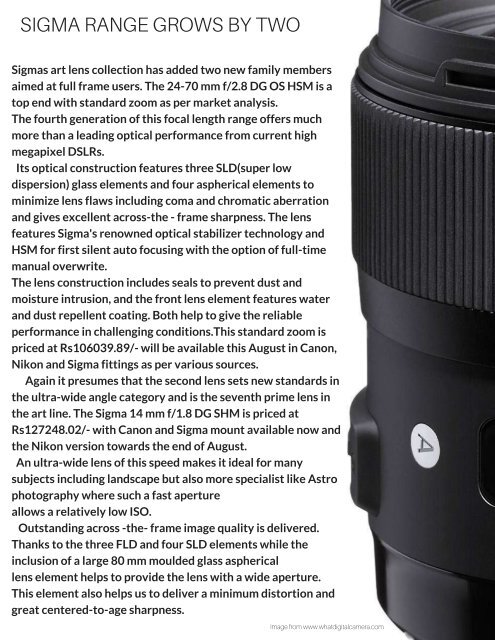INSIDE PHOTOGRAPHY SEPTEMBER,2017
Create successful ePaper yourself
Turn your PDF publications into a flip-book with our unique Google optimized e-Paper software.
SIGMA RANGE GROWS BY TWO<br />
Sigmas art lens collection has added two new family members<br />
aimed at full frame users. The 24-70 mm f/2.8 DG OS HSM is a<br />
top end with standard zoom as per market analysis.<br />
The fourth generation of this focal length range offers much<br />
more than a leading optical performance from current high<br />
megapixel DSLRs.<br />
Its optical construction features three SLD(super low<br />
dispersion) glass elements and four aspherical elements to<br />
minimize lens flaws including coma and chromatic aberration<br />
and gives excellent across-the - frame sharpness. The lens<br />
features Sigma's renowned optical stabilizer technology and<br />
HSM for first silent auto focusing with the option of full-time<br />
manual overwrite.<br />
The lens construction includes seals to prevent dust and<br />
moisture intrusion, and the front lens element features water<br />
and dust repellent coating. Both help to give the reliable<br />
performance in challenging conditions.This standard zoom is<br />
priced at Rs106039.89/- will be available this August in Canon,<br />
Nikon and Sigma fittings as per various sources.<br />
Again it presumes that the second lens sets new standards in<br />
the ultra-wide angle category and is the seventh prime lens in<br />
the art line. The Sigma 14 mm f/1.8 DG SHM is priced at<br />
Rs127248.02/- with Canon and Sigma mount available now and<br />
the Nikon version towards the end of August.<br />
An ultra-wide lens of this speed makes it ideal for many<br />
subjects including landscape but also more specialist like Astro<br />
photography where such a fast aperture<br />
allows a relatively low ISO.<br />
Outstanding across -the- frame image quality is delivered.<br />
Thanks to the three FLD and four SLD elements while the<br />
inclusion of a large 80 mm moulded glass aspherical<br />
lens element helps to provide the lens with a wide aperture.<br />
This element also helps us to deliver a minimum distortion and<br />
great centered-to-age sharpness.<br />
Image from www.whatdigitalcamera.com


